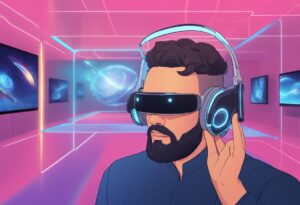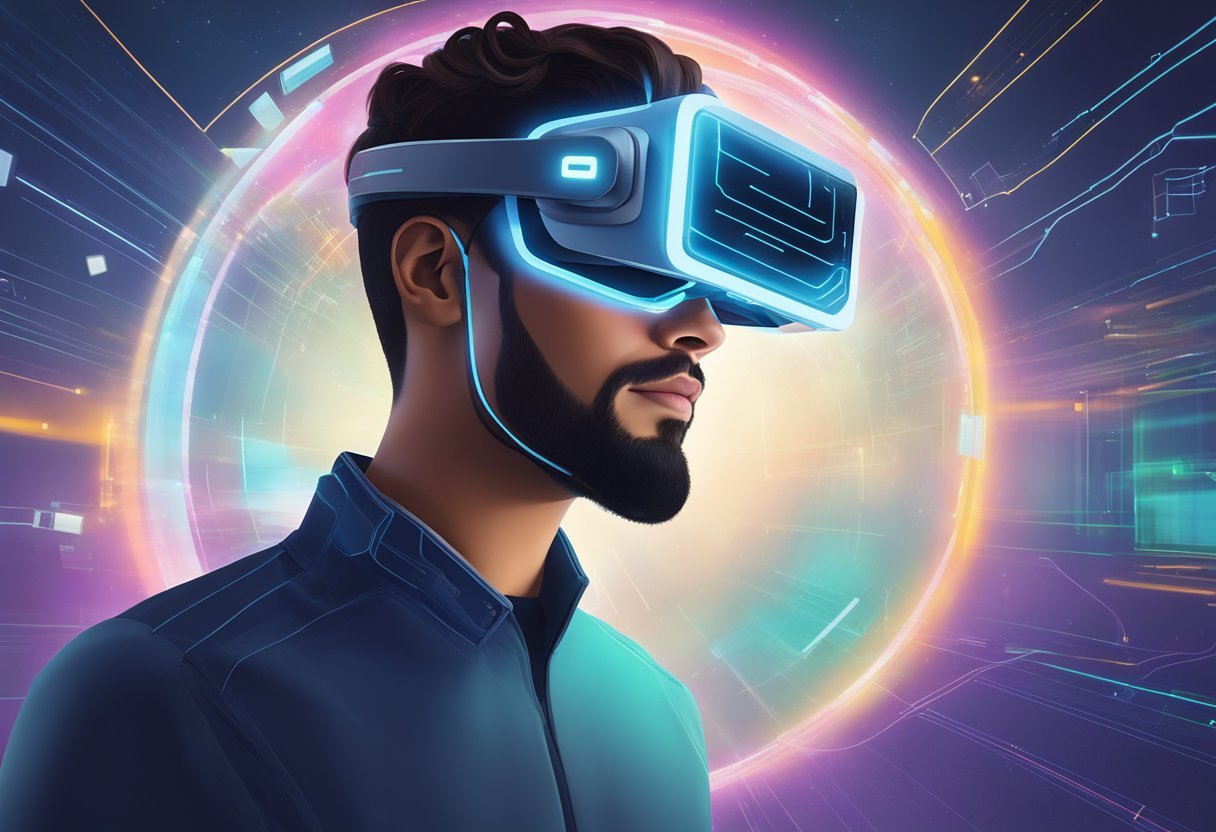AR technology is a rapidly growing field that combines the real world with computer-generated content to create an interactive experience. AR can be defined as a system that incorporates real and virtual worlds, real-time interaction, and accurate 3D registration of virtual and real objects. Unlike virtual reality (VR), which creates a completely artificial environment, AR users experience a real-world environment with generated perceptual information overlaid on top of it.
AR technology has a wide range of applications, from gaming and entertainment to product visualization, marketing campaigns, architecture and home design, education, and industrial manufacturing. AR technology has the potential to revolutionize the way we interact with the world around us by enhancing our perception of reality. The technology is becoming increasingly accessible to the general public, with many smartphones and tablets now equipped with AR capabilities.
As AR technology continues to evolve, it is expected to have a significant impact on various industries, including healthcare, education, and retail. The potential for AR technology is vast, and it is expected to become an integral part of our daily lives in the near future.
Fundamentals of AR Technology
Augmented Reality (AR) is a technology that integrates digital information with the real world, creating an interactive experience. AR enhances the real environment by overlaying digital information, such as graphics, text, and images, onto the physical environment. ARCore and ARKit are the most popular AR platforms that provide developers with tools to build AR applications.
AR technology requires hardware components such as sensors, lenses, and displays. AR devices use sensors such as accelerometers and gyroscopes to detect motion and orientation. The display projects digital information onto the user’s field of view, creating a heads-up display (HUD). AR software uses machine vision to recognize gestures and movements, enabling interaction with the digital elements.
Evolution of AR Devices
AR devices have evolved from bulky head-mounted displays (HMDs) to lightweight glasses and contact lenses. Google Glass was the first commercially available AR device, but it failed due to privacy concerns and a lack of practical use cases. Snapchat and Pokemon Go popularized AR technology on smartphones, and Microsoft Hololens introduced a new era of AR devices with a fully immersive experience.
AR technology has also benefited from advancements in computing power and big data. Mobile computing has made AR accessible to everyday consumers, and AR devices are becoming more sophisticated with each iteration. AR technology has the potential to revolutionize industries such as healthcare, education, and entertainment, by creating new ways to interact with the natural environment.
AR technology is an exciting field that has the potential to transform the way we interact with the world around us. As hardware and software continue to improve, AR devices will become more immersive and practical, creating new opportunities for developers and users alike.
Most Important AR Technology

Augmented Reality (AR) technology has witnessed significant advancements in recent years, with multiple technologies contributing to its growth. Below are the top 10 most important AR technologies that are driving the industry forward:
- Computer Vision
- Markerless Tracking
- Simultaneous Localization and Mapping (SLAM)
- Object Recognition
- Augmented Reality SDKs
- Cloud-Based AR
- Geolocation Services
- Gesture Recognition
- Wearable Devices
- Holographic Displays
Computer Vision
Computer vision is a technology that enables computers to interpret and understand digital images and videos. It is a critical component of AR technology, as it helps devices recognize and track real-world objects and environments. Computer vision technology is used in AR applications to identify objects, recognize patterns, and track movements.
Markerless Tracking
Markerless tracking is a technology that enables AR devices to track real-world objects without the need for markers or special codes. It is used in AR applications to track the position and orientation of objects in real-time, allowing users to interact with digital content in a more natural way.
Simultaneous Localization and Mapping (SLAM)
SLAM is a technology that enables AR devices to create a map of the real world and track their position within it. It is used in AR applications to create accurate representations of real-world environments, allowing users to interact with digital content in a more natural and immersive way.
Object Recognition
Object recognition is a technology that enables AR devices to recognize and identify real-world objects. It is used in AR applications to overlay digital content onto real-world objects, allowing users to interact with them in new and exciting ways.
Augmented Reality SDKs
Augmented Reality Software Development Kits (SDKs) are software tools that enable developers to create AR applications. They provide developers with the necessary tools and resources to create AR applications that can run on various devices and platforms.
Cloud-Based AR
Cloud-based AR is a technology that enables AR applications to be run on cloud-based servers. It allows AR applications to be run on low-end devices, as most of the processing is done on the cloud server.
Geolocation Services
Geolocation services are a technology that enables AR devices to determine their location and orientation in the real world. It is used in AR applications to provide users with location-based information and services.
Gesture Recognition
Gesture recognition is a technology that enables AR devices to recognize and interpret hand gestures and movements. It is used in AR applications to allow users to interact with digital content using hand gestures and movements.
Wearable Devices
Wearable devices are devices that are worn on the body, such as smart glasses and smartwatches. They are used in AR applications to provide users with a more natural and immersive experience, allowing them to interact with digital content in a hands-free way.
Holographic Displays
Holographic displays are a technology that enables AR devices to project digital content into the real world in 3D. It is used in AR applications to provide users with a more immersive and realistic experience, allowing them to interact with digital content in a more natural way.
These 10 most important AR technologies are driving the industry forward and are essential components of any AR application. As technology continues to advance, we can expect to see even more exciting developments in the world of AR.
AR in Various Industries

Retail and E-Commerce
AR technology is revolutionizing the retail and e-commerce sector by providing a personalized shopping experience to customers. Retailers are using AR to offer virtual try-ons, product demonstrations, and real-time product information.
AR-powered shopping apps allow customers to visualize products in their real-world environment before making a purchase. This technology has proven to increase sales and customer engagement, making it a valuable tool for the retail industry.
Healthcare and Medical Training
AR technology is making a significant impact on healthcare and medical training. Medical professionals are using AR to simulate real-world scenarios, providing a safe and effective way to train medical students and professionals.
AR technology is also being used to improve decision-making during surgeries and to enhance the accuracy of medical procedures. AR is transforming the healthcare industry by providing innovative solutions that improve patient outcomes.
Military and Public Safety
AR technology is playing a critical role in military and public safety operations. AR provides real-time information to soldiers and law enforcement officers, enabling them to make quick and informed decisions.
AR technology is also being used to simulate real-world scenarios, allowing soldiers and officers to train in a safe and controlled environment. AR technology is transforming the military and public safety industries by providing innovative solutions that improve safety and efficiency.
Education and Research
AR technology is transforming the education and research industries by providing innovative solutions that enhance learning and research experiences. AR technology is being used to create engaging and interactive learning experiences, allowing students to visualize complex concepts in a more accessible way.
AR technology is also being used to enhance research by providing real-time data visualization and analysis. AR technology is transforming the education and research industries by providing innovative solutions that improve learning outcomes and research productivity.
Entertainment and Gaming
AR technology is transforming the entertainment and gaming industries by providing immersive and interactive experiences. AR-powered games and experiences allow users to interact with the digital world in a real-world environment, creating a unique and engaging experience.
AR technology is also being used to enhance live events, such as football games, by providing real-time information and statistics to fans. AR technology is transforming the entertainment and gaming industries by providing innovative solutions that enhance user engagement and experience.
Architecture and Real Estate
AR technology is transforming the architecture and real estate industries by providing innovative solutions that enhance visualization and interaction. AR technology is being used to create virtual tours of properties, allowing buyers to visualize properties in a more immersive way.
AR technology is also being used to enhance architectural design by providing real-time feedback and object recognition. AR technology is transforming the architecture and real estate industries by providing innovative solutions that improve customer engagement and design outcomes.

User Experience and Interaction
The Role of User Interface
User interface plays a critical role in creating an immersive and intuitive AR experience. A well-designed interface should be easy to use, responsive, and intuitive. The interface should provide users with clear instructions and guidance on how to interact with the AR content.
AR applications should also be designed to work seamlessly with input devices such as touchscreens, voice recognition, and gesture recognition.
Enhancing Real-World Interactions
AR technology has the potential to revolutionize the way people interact with the world around them. By overlaying digital content onto the real world, AR can enhance everyday life experiences such as navigation, sightseeing, and entertainment. AR can also be used in fields such as archaeology to reconstruct and visualize historical sites.
AR technology can be marker-based or marker-less. Marker-based AR uses markers such as QR codes or images to trigger the display of digital content. Marker-less AR, on the other hand, uses sensory information such as GPS, camera, and sound to overlay digital content onto the real world.
The latency of AR applications is a crucial factor in creating a seamless user experience. AR applications should be designed to minimize latency and provide users with real-time feedback. Machine learning can be used to improve the accuracy and speed of AR applications.
AR technology has the potential to revolutionize the way people interact with the world around them. A well-designed user interface is critical in creating an immersive and intuitive AR experience. AR technology can enhance everyday life experiences and be used in fields such as archaeology to reconstruct and visualize historical sites.
Technological Advancements and Challenges
Cutting-Edge AR Hardware
AR technology has been advancing rapidly, with cutting-edge hardware such as VR headsets and smartphones providing users with a range of immersive experiences. These devices offer a range of visual elements that can be used to create digital visual elements that can be overlaid onto the real world.
With the advent of extended reality, users can now experience sensory stimuli that are not limited to the visual realm. However, the challenge for AR hardware manufacturers is to create devices that are both lightweight and powerful enough to deliver a seamless experience.
Software and Application Development
The development of AR applications and software has been a major focus for the industry. With the increasing popularity of AR, there has been a surge in the development of AR applications for a range of industries, including gaming, education, and healthcare.
The challenge for developers is to create applications that are user-friendly and provide a seamless experience. Developers must ensure that their applications are compatible with a range of devices and platforms, including smartphones, tablets, and VR headsets.
Overcoming Technical Limitations
Despite the rapid advancements in AR technology, there are still technical limitations that need to be overcome. One of the biggest challenges is the ubiquitous nature of AR. The technology must be able to function in any environment and under any lighting conditions.
AR technology must be able to provide users with a seamless experience without any lag or latency issues. Another challenge is the development of a metaverse, which requires a level of interoperability between different AR applications and platforms. Finally, the technology must be able to provide users with a high-quality experience that is comparable to that of a traditional screen.
Future of AR Technology
Integration with Other Technologies
AR technology has already shown its potential in various fields such as healthcare, public safety, tourism, shopping apps, and entertainment and gaming. However, the future of AR technology lies in its integration with other technologies.
AR technology can be integrated with machine learning, computer vision, and gesture recognition to create a more immersive and interactive experience. With the advent of the metaverse, AR technology can be used to create a ubiquitous digital world where users can seamlessly move between the real world and the digital world.
Impact on Society and Everyday Life
AR technology has the potential to revolutionize the way people interact with the world around them. With the use of AR glasses and smartphones, users can easily access digital visual elements that are overlaid onto the real world environment.
This technology can be used to enhance navigation, public safety, and shopping experiences. AR technology can be used to create digital information screens that can be accessed anywhere, anytime. In healthcare, AR technology can be used to provide doctors with real-time information during surgery, improving patient outcomes.
The future of AR technology is bright, and it is expected to have a significant impact on society and everyday life. As the technology continues to evolve, it will become more accessible and user-friendly, leading to increased sales and adoption.
AR technology has the potential to change the way people interact with the world around them, creating a more immersive and interactive experience that seamlessly integrates the real world with the digital world.
Frequently Asked Questions
How does augmented reality enhance user experience?
Augmented reality enhances user experience by superimposing digital elements onto the real-world environment. This technology allows users to interact with the digital world in a more natural and intuitive way, making it easier to understand and engage with complex information.
AR also provides users with a more immersive experience, allowing them to explore and interact with digital content in a way that was not previously possible.
What are the latest advancements in augmented reality technology?
The latest advancements in augmented reality technology include improvements in hardware, software, and user interfaces. AR glasses have become more lightweight and comfortable, while also offering higher resolution and more accurate tracking.
Software advancements have also made it easier to create and deploy AR applications, with new tools and libraries making it possible to create more complex and sophisticated AR experiences.
In what ways is AR technology being utilized in the fashion industry?
AR technology is being utilized in the fashion industry in a number of ways. One example is AR-enabled shopping experiences, which allow users to try on clothes virtually before making a purchase. AR is also being used to create virtual fashion shows and to enhance the overall customer experience in retail stores.
What are the key components necessary for augmented reality systems?
The key components necessary for augmented reality systems include hardware (such as AR glasses or smartphones), software (such as AR development platforms), and content (such as 3D models or digital assets). Other important components include sensors for tracking user movement and position, as well as cameras for capturing the real-world environment.
How do AR glasses differ from other augmented reality devices?
AR glasses differ from other augmented reality devices in that they are worn on the user’s face and provide a more immersive experience. AR glasses typically offer a wider field of view and more accurate tracking than other devices, making them ideal for applications where users need to interact with digital content in a more natural and intuitive way.
What distinguishes augmented reality from virtual reality?
Augmented reality differs from virtual reality in that it overlays digital content onto the real-world environment, while virtual reality creates a completely immersive digital environment. AR allows users to interact with digital content while still being aware of their real-world surroundings, while VR completely replaces the real-world environment with a digital one.




